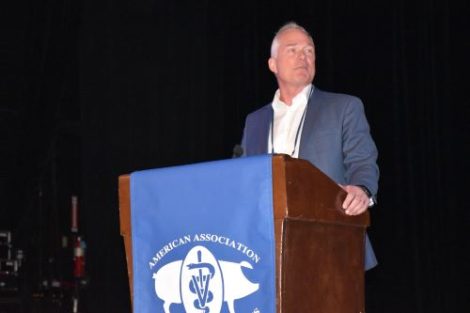
At the recent American Association of Swine Veterinarians conference, attendees were treated to an enlightening presentation by Dr. Joel Nerem, Veterinarian at Pipestone Veterinary Services. Dr. Nerem, delivering the prestigious Howard Dunne Lecture, provided invaluable insights into the future of swine veterinary medicine under the theme, “Next Generation Swine Veterinarians: Who are we and where are we going?”
Understanding the Landscape
The global swine industry stands at a critical juncture, facing an array of challenges that threaten its sustainability and profitability. From the persistent threat of diseases like Porcine Reproductive and Respiratory Syndrome (PRRS) virus and the emergence of African Swine Fever (ASF) in new regions, to the evolving demands of consumers for sustainable and ethically produced pork products, the landscape is complex and dynamic. However, amidst this uncertainty, the key lies in adhering to the principles established by our veterinary predecessors: prioritize the well-being of the pig, the success of the farmer, and the expectations of the consumer. By centering our focus on these fundamental pillars, we can navigate the evolving landscape of the swine industry with clarity and purpose, ensuring a balanced approach that serves the interests of all stakeholders.
Focus on the Pig
Improving health stands as the cornerstone of veterinary practice within the swine industry. Dr. Nerem stressed the importance of prioritizing health interventions that not only improve animal well-being but also enhance farm profitability. Drawing from recent data and research, he highlighted the escalating issue of wean-to-finish mortality and the importance to address it through enhanced health management practices.
While traditional approaches to disease prevention and treatment remain vital, advancing the health of the U.S. swine herd demands innovative strategies and a renewed focus on biosecurity and system design. Key points for consideration include:
- Understanding Disease Costs: Recognizing the economic burden of diseases on pig farms is crucial for informed decision-making and effective strategy development.
- Next Generation Biosecurity: Enhancing biosecurity measures, particularly in wean-to-market facilities, is imperative for reducing disease transmission and safeguarding herd health.
- Optimizing Farm Design: Advocating for farm and production system redesigns, such as relocating sow farms away from densely populated areas and implementing all-in/all-out management for growing pig sites, can mitigate disease risks and optimize farm profitability.
- Disease Elimination Initiatives: While challenges persist, targeted efforts towards disease elimination, both at the farm level and nationally, present opportunities for enhancing swine health and industry sustainability.
Moreover, championing pig welfare emerges as another vital aspect of veterinary practice, aligning with the profession’s commitment to animal well-being and industry integrity. Prioritizing swine welfare not only enhances pig performance but also addresses consumer concerns and fosters public trust. It is imperative for veterinarians to actively engage with experts, collaborate on welfare initiatives, and continually innovate to ensure the well-being of pigs across all aspects of production.
Focus on the Farmer
The success of the swine industry is intrinsically linked to the prosperity of pig farmers. Improving the health, welfare, and performance of pigs inherently contributes to the well-being and profitability of farmers, particularly amidst challenging market conditions and the looming threat of foreign animal disease (FAD). To champion FAD preparedness, several key initiatives must be prioritized:
- Secure Pork Supply Plan: Ensuring that every farm site has a comprehensive Secure Pork Supply plan in place to facilitate swift and effective responses to potential FAD incursions.
- Enhanced Traceability: Implementing a “Next Generation” traceability system characterized by real-time tracking, accuracy in geolocation data, ease of use akin to modern consumer platforms, and mandatory industry-wide compliance.
- Collaborative Efforts: Facilitating collaborative partnerships among industry stakeholders, including veterinarians, farmers, academia, government agencies, and meat packing industries, to synergize efforts and optimize FAD preparedness strategies.
By fostering collaboration and implementing robust traceability measures, the swine industry can bolster its resilience against FAD threats, safeguard farmer livelihoods, and maintain consumer confidence in the integrity and safety of U.S. pork products.
Focus on the Consumer
Consumer preferences and demands are increasingly shaping the landscape of the swine industry, presenting both challenges and opportunities for farmers and veterinarians alike. While traditionally focused on serving the farmer, veterinarians must now recognize the indirect influence consumers wield over farming practices and pork production.
This shift is evident in a myriad of consumer-driven trends and regulations, including the rise of Certified Organic products, the demand for Ractopamine-free pork, and initiatives such as “No Antibiotics Ever” production and Antibiotic Use Tracking regulations in certain regions. Prop 12, the Common Swine Industry Audit, and advancements like Gene Edit technology further underscore this evolving consumer-driven paradigm.
Recognizing the inevitability of these changes, veterinarians must actively engage with consumer preferences, viewing them not only as challenges but as opportunities to enhance both pig health and farmer profitability. Early adoption of practices aligned with consumer demands can potentially unlock new revenue streams for farmers, while also promoting the welfare of the animals under their care. Thus, veterinarians play a vital role in navigating and shaping how these consumer-driven demands are met, ultimately benefiting both the pigs and the farmers they serve.
Looking to the Future
As Dr. Nerem concluded his presentation, he left his audience with a sense of optimism and determination. While the challenges facing the swine industry are significant, he emphasized that they also present opportunities for innovation, growth, and positive change. By embracing a “Next Generation” mindset and working collaboratively to address the needs of pigs, farmers, and consumers, veterinarians can build upon the foundation laid by their predecessors and lead the industry into a new era of success and sustainability.
